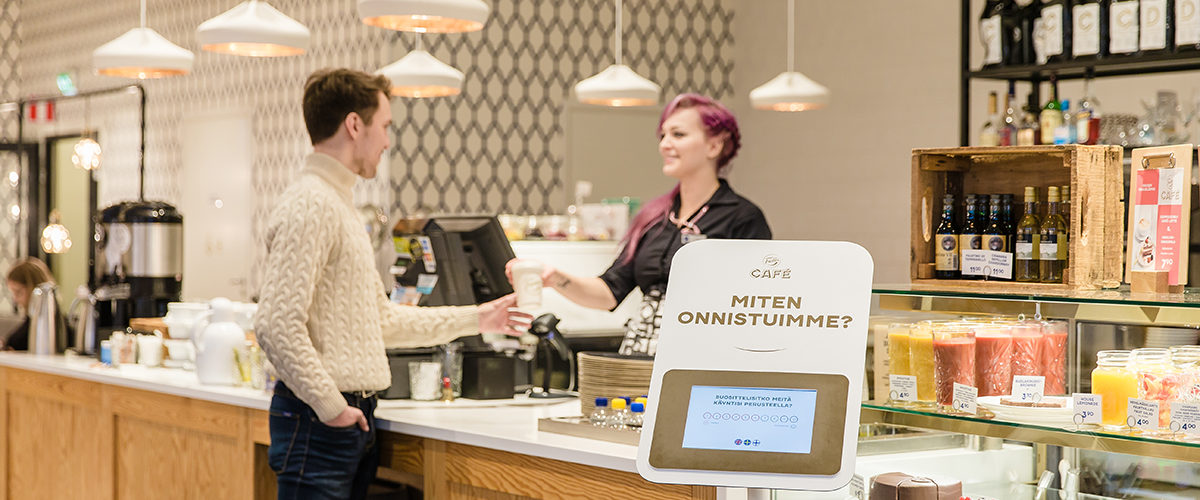To many companies ensuring good customer experience is self-evident. They have understood that satisfied customers are the heart of the company. Customer demands have increased during the past decade and it’s not a passing trend. To ensure and sustain customer satisfaction, you need to measure customer experience regularly and extensively. The benefits of measuring customer experience are so significant that every single company should start paying attention to customer experience if they haven’t already. This is the TOP10 of the most important benefits:
1. Customer retention (is less expensive than new customer acquisition)
Satisfied customers are more likely to come back and buy more and more often. Retaining existing customers is less expensive than acquiring new ones: new customer acquisition is, depending on the industry, five to 25 times more expensive than retaining the existing ones.
2. Customer advocacy
Not only do satisfied customers return over and over again, they also bring their friends and colleagues with them by recommending the service they received. According to a study, 82% of consumers ask for recommendations from their inner circle before making a purchasing decision. And unsatisfied customers repel an even bigger group of potential customers, because negative customer experiences are shared much more likely than positive ones. According to a study, over half of negative experiences were shared to over five people, compared to only a third of positive ones.
3. Word-of-mouth (WOM)
In the era of social media, customer experiences spread faster and wider than ever before. Customer experiences aren’t shared only to people you know but to everyone. The experiences of previous customers really do matter, since up to 71% of consumers look for information on social media and 88% of consumers on the Internet before reaching a purchasing decision. The numbers among B2B customers are similar.
4. Increasing sales
Good customer experience increases sales because existing customers buy more and more often and bring new customers with them. Good customer experiences boost also cross-selling and upselling.
5. Customer experience as a competitive advantage
High customer satisfaction can be exploited in marketing and it appeals to customers. As previously mentioned, the experiences and reviews of existing customers have a significant impact on purchasing decisions in both B2C and B2B markets. Good customer experiences create not only a positive company image but also a positive employer image which makes attracting good employees much easier.
6. Committing staff
Measuring customer experience motivates staff to serve their customers ever better and helps develop own work according to the feedback. Staff can be trained and rewarded according to customer experience data and committed to the success of the organization. Also, customer satisfaction affects employee experience as well: everyone prefers working with satisfied customers. (And employee experience is shown to correlate with customer experience.)
7. Continuous development and resource allocation
Customer experience data offers the tools to improve customer experience and when measured continuously, you get long-term trends that offer a lot more information than a single snapshot. Thereby customer experience, customer service and internal processes can be developed according to reliable, long-term data. The impact of changes made can be monitored and resources can be allocated to the areas that have the greatest effect on success.
8. Quick reacting
Continuous, real-time customer experience measuring enables reacting to problems immediately. Before word-of-mouth gets started and customers churn, you can fix problems quickly. You can monitor the impact of the changes made in real-time as well and ensure that things really are going smoothly. Problems can also be actively prevented, like Finavia does at the Helsinki airport: our Touchless feedback devices are used to ensure the cleanliness of the restrooms. After a certain amount of negative feedback, the cleaning staff is automatically alerted.
9. Comparison data and best practices
Customer experience data enables internal organizational comparison, for example by services, locations or time periods. Measuring customer experience continuously and real-time helps find not only the problem areas but also the best practices within the organization. Thus, they can be copied to ensure higher customer satisfaction across the whole organization.
10. Good customer experience is a prerequisite for growth
Studies show that customer satisfaction correlates with business growth. If a company wants to succeed and grow, it has to ensure good customer experience and high customer satisfaction.
The benefits of measuring customer experience are reined in most efficiently when the results are real-time, explicit and easily usable. Customer surveys that are done once a year don’t produce enough useful information and what is asked and how, is in a key role. It really is worthwhile to measure customer experience together with professionals so that the results provide as great a benefit as possible. You should create a process around the handling of customer experience data and name people responsible within the organization so that the feedback really is used to improve customer experience. If you need help in measuring customer experience, go ahead and contact us.


